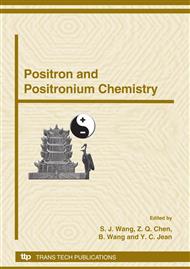p.99
p.102
p.105
p.108
p.111
p.114
p.117
p.122
p.125
Hydrogen- and Corrosion-Related Defect Characterization of Iron and Steels Using a Slow Positron Beam
Abstract:
Hydrogen- and corrosion -related defects of pure iron and AISI 304 and 316 stainless steels were investigated by measuring Doppler broadening energy spectra of positron annihilation. The significant increase in S-parameter after corrosion in iron was interpreted as due to the formation of defects and voids during corrosion processes. However, a decrease of the S-parameter in AISI 304 and 316 stainless steels after corrosion was interpreted as dissolution of passivity oxide film. Furthermore, similar results in iron and stainless steels after hydrogen-charging were observed. Hydrogen damage between the surface and the bulk has a significant variation with depth. The larger increase in S-parameter near the surface after hydrogen-charging mainly comes from the formation of large-size defects (e.g. voids); however the increase in S-parameter in the bulk after hydrogen-charging mainly comes from the production of small-size defects.
Info:
Periodical:
Pages:
111-113
Citation:
Online since:
November 2008
Authors:
Keywords:
Price:
Сopyright:
© 2009 Trans Tech Publications Ltd. All Rights Reserved
Share:
Citation:


